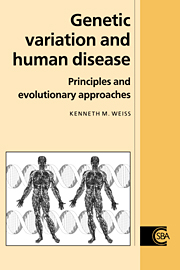Book contents
- Frontmatter
- Contents
- Frontispiece
- Preface: what is this book all about?
- Notational conventions used in this book
- List of abbreviations
- Part I Genes and their expression
- Part II Introduction to genetic epidemiology: inference from observational data
- Part III Evolution: the time dimension in populations
- 9 Genes over time and space
- 10 Reconstructing history: the footprints of evolution
- 11 Evolution generates heterogeneity
- Part IV Modification of the inherited genotype: the time dimension in individuals
- Afterwords: towards a unified general model
- References
- Index
10 - Reconstructing history: the footprints of evolution
from Part III - Evolution: the time dimension in populations
Published online by Cambridge University Press: 05 June 2012
- Frontmatter
- Contents
- Frontispiece
- Preface: what is this book all about?
- Notational conventions used in this book
- List of abbreviations
- Part I Genes and their expression
- Part II Introduction to genetic epidemiology: inference from observational data
- Part III Evolution: the time dimension in populations
- 9 Genes over time and space
- 10 Reconstructing history: the footprints of evolution
- 11 Evolution generates heterogeneity
- Part IV Modification of the inherited genotype: the time dimension in individuals
- Afterwords: towards a unified general model
- References
- Index
Summary
And, departing, leave behind us
Footprints on the sands of time.
H. W. Longfellow, ‘A Psalm of Life’ (1839)It may seem peculiar that genetic diseases, being deleterious and presumably selected against, exist at all. Yet, a number of genetic diseases, especially severely deleterious recessive conditions, have substantial incidence at birth. This chapter and the next illustrate the impact of evolution on the frequency and distribution of genetic disease.
What is responsible for the observed frequency of disease?
How often do mutations introduce new copies of diseaseproducing alleles?
A classical problem in human genetics has been to estimate how often new mutants leading to a given disease are produced. Interestingly, although the loci responsible vary tremendously in length, physiology, etc., a large number of studies, using very different methods, have reached similar estimates. For alleles related to both recessive and dominant qualitative traits, new mutations occur about every 100 000 meioses (i.e., μ ≈ 10-5) {Vogel and Motulsky, 1986}. The range of these estimates is about 100-fold, which roughly encompasses the range of size of coding regions of the genes involved, so that overall the rate per nucleotide per generation is consistently around 10-7 to 10-9.
What maintains the frequency of disease-related alleles?
Other important questions, perhaps not asked as often as they should be, are: what factors maintain the observed frequency of alleles that are deleterious? is it selection? do the alleles affect fitness?
- Type
- Chapter
- Information
- Genetic Variation and Human DiseasePrinciples and Evolutionary Approaches, pp. 180 - 204Publisher: Cambridge University PressPrint publication year: 1993



